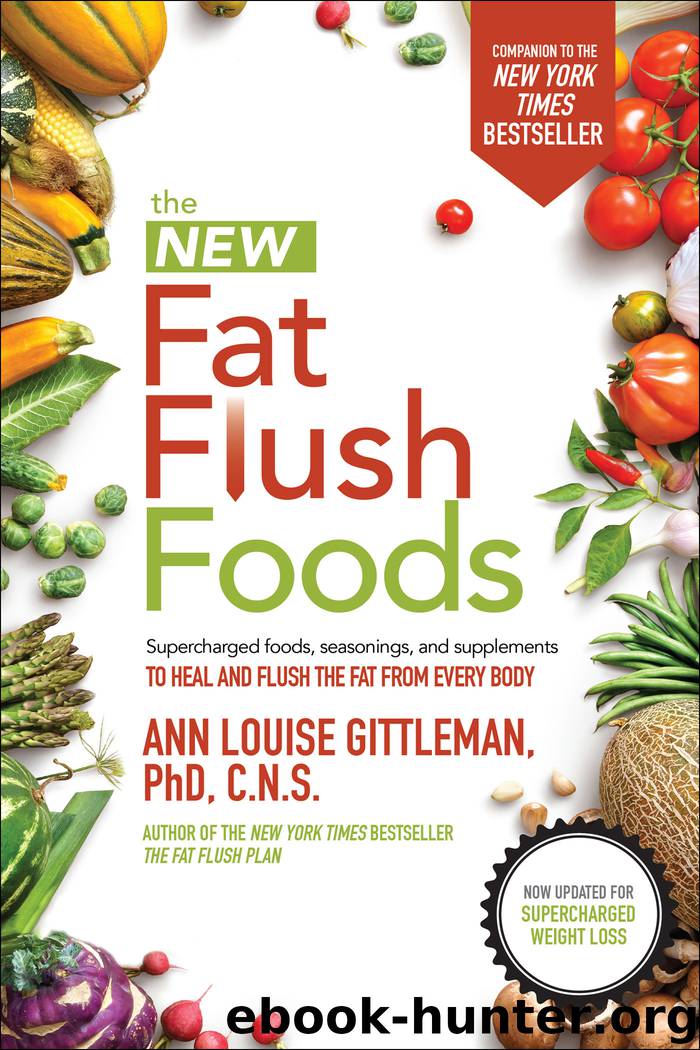The New Fat Flush Foods by Ann Louise Gittleman

Author:Ann Louise Gittleman
Language: eng
Format: epub
Publisher: McGraw-Hill Education
Published: 2017-04-09T04:00:00+00:00
THINK TWICE!
• Keep cayenne away from your eyes and moist mucous membranes.
• When making smoothies, don’t mistake your bottle of cayenne for cinnamon. This happened to one unlucky Fat Flusher who experienced a whole new taste sensation that morning!
IT’S BEEN SAID . . .
I’ve banished my salt and pepper shakers. Instead, I keep a container of cayenne on the table so I can rev up my metabolism at most every meal.
JULIE T., WASHINGTON
CINNAMON
Once considered a precious commodity, cinnamon boasts a long history as both a spice and a medicine. Cinnamon is actually tree bark and can be found in dried stick form or as a ground powder. True cinnamon comes from Ceylon and is difficult to find in U.S. stores. Tan in color, it offers a delicate aroma and a sweeter flavor than the more common, less expensive “cassia” cinnamon. If the cinnamon in your cupboard is mahogany red, it is cassia and was probably grown in Vietnam, China, Indonesia, or Central America.
Medieval physicians treated coughs, sore throats, and diarrhea with cinnamon. Europeans used cinnamon to preserve foods and to mask the stench and flavor of spoiling meats. And it turns out that they were on to something. Recent studies have confirmed cinnamon’s ability to rid foods of dangerous bacteria. One study, conducted at Kansas State University, found that cinnamon destroyed E. coli bacteria in apple juice.
The healing powers of cinnamon’s active ingredients (cinnamaldehyde, cinnamyl acetate, and cinnamyl alcohol) don’t end there. Cinnamon has been well researched for its ability to prevent unwanted clumping of blood platelets. Cinnamon consumption can boost the metabolism and derail candida, the microorganism that causes yeast overgrowth in the body. The calcium and fiber content of cinnamon seems to improve intestinal health and protect against heart disease. And best of all, in both test-tube and animal studies, scientists at the U.S. Department of Agriculture have found that cinnamon makes cells more responsive to insulin. Clinical trials with humans are currently under way, but it appears that just a dash of cinnamon can help the body to metabolize glucose, keeping blood sugar levels in check.
I only recommend Ceylon cinnamon because most commercial cinnamons contain the liver-damaging ingredient coumarin that can be harmful to health when taken in excess. Cinnamon in general, however, is most helpful in controlling blood sugar levels so that insulin spikes are kept in check, and it can even reduce the glycemic impact of a meal by nearly 30 percent. As a delicious metabolism booster, cinnamon can rock desserts, lamb, coffee, tea, and smoothies.
Download
This site does not store any files on its server. We only index and link to content provided by other sites. Please contact the content providers to delete copyright contents if any and email us, we'll remove relevant links or contents immediately.
Nutrition for Sport, Exercise, and Health by Spano Marie & Kruskall Laura & Thomas D. Travis(3563)
Nutrition for Sport, Exercise, and Health by Marie Spano & Laura Kruskall & D. Travis Thomas(3557)
The Sprouting Book by Ann Wigmore(3423)
Flavor Flours by Alice Medrich(2652)
Memory Rescue by Daniel G. Amen(2270)
Superfood Smoothie Bowls: Delicious, Satisfying, Protein-Packed Blends that Boost Energy and Burn Fat by Chace Daniella(2242)
Dirty Genes by Ben Lynch(2168)
The Bad Food Bible by Aaron Carroll(2127)
The Poisoner's Handbook by Deborah Blum(1990)
Genius Foods by Max Lugavere(1980)
Good Calories, Bad Calories by Gary Taubes(1958)
The Main Street Vegan Academy Cookbook by Victoria Moran(1946)
The I Quit Sugar Cookbook by Sarah Wilson(1882)
Core Performance Essentials by Mark Verstegen(1866)
Memory Rescue: Supercharge Your Brain, Reverse Memory Loss, and Remember What Matters Most by Amen Dr. Daniel G(1856)
Big Girls Do It Stronger by Jasinda Wilder(1811)
Android App Development by Franceschi Hervé J.;(1740)
Sugar Crush by Dr. Richard Jacoby(1691)
Dr. Colbert's Keto Zone Diet by Don Colbert(1552)
